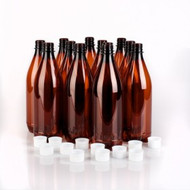1. Brew an ale rather than a lager
While many branded starter equipment kits include a lager, they require a bit more attention and are less forgiving than brewing ales. They need to be brewed cooler and require more yeast for best fermentation. For those reasons, we suggest your first few brews are ales. In general, the darker the beer the more forgiving it will be in your brewing.
2. A beer kit is not enough on its own
A pre-hopped beer kit on its own isn't enough to brew a decent beer. Adding sugar or dextrose alone will often create a thin, dry beer. To get a reasonable body and flavour you'll need to add more malt in some form - liquid or dry malt extract, for example - or an enhancer pack. Many kits recommend such additions within their instructions.
3. Temperature is important
The temperature of fermentation is an important part of flavour production. The same beer fermented a few degrees higher, or lower, will result in a different tasting beer. In addition, maintaining a constant temperature is equally important as yeast will react in different ways to temperature fluctuations, and not usually in a good way for your beer. As a rough guide, brew lagers between 10-14 degrees, and ales between 18-21 degrees.
4. Don't bottle as soon as the airlock stops
While you may feel compelled to bottle your brew when the activity seems to have stopped, there may still be some quiet activity going on with the fermentation. If the yeast hasn't finished fermenting when you bottle, you may end up with exploding bottles so ensure it has finished before doing so. Leave it a few days after it appears to have finished, or even a week or more - it won't hurt the beer, in fact the yeast do a clean-up job afterwards and this can benefit your beer.
5. Use a hydrometer
Understanding what your fermentation is doing will help ensure a successful brew and encourage improvement in your brewing. A hydrometer to measure the gravity before, during and after fermentation is part of that process. If nothing else, it will help you work out the amount of alcohol in the beer and you'll know when the fermentation has finished.
